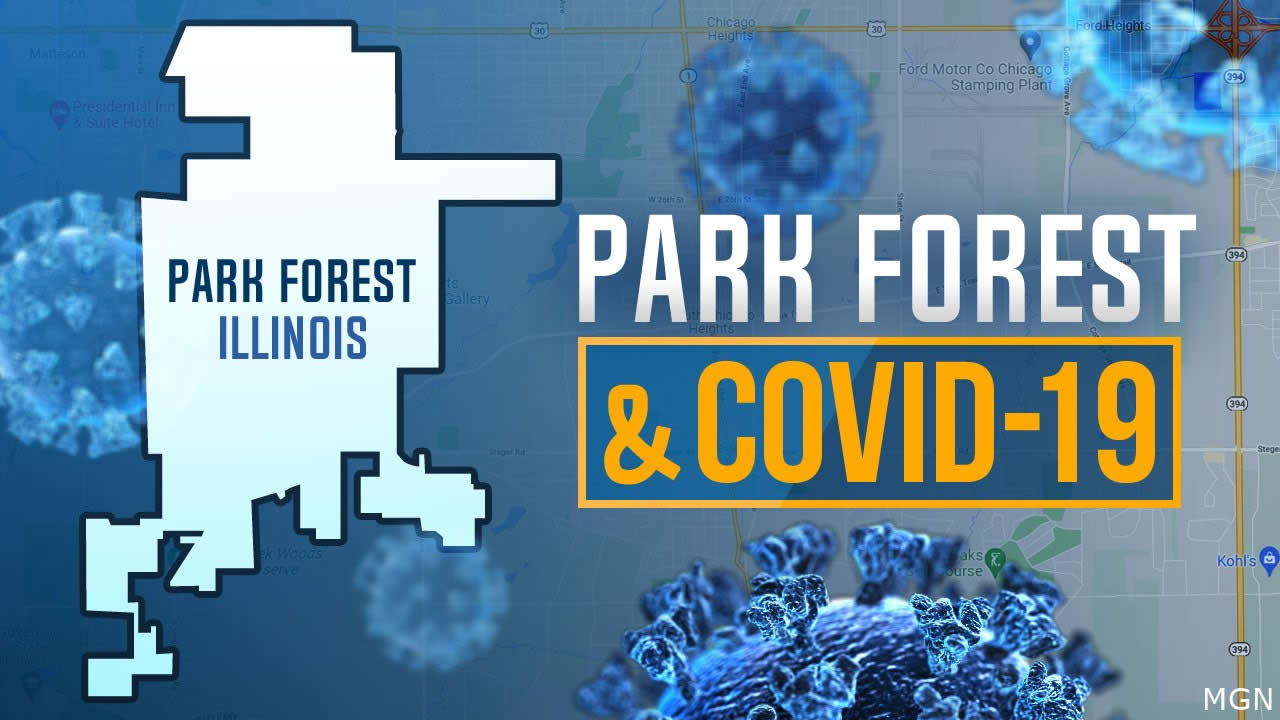
Park Forest, IL-(ENEWSPF)- The thirty municipalities we track have suffered 460 COVID-19 related deaths according to information provided by the Cook County Medical Examiner’s Office.
The overall recovery rate in Illinois holds at 94%. However, the Institute for Health Metrics and Evaluation (IHME), an independent global health research center at the University of Washington, now predicts upwards of 179,601 people in the United States will die of the virus by October 1, 2020. This is largely due to states that relaxed social distancing prematurely or never properly embraced it.
Cicero still tops the list of the 30 towns we survey with 2943 people testing positive for COVID-19, now at 3508 people per 100,000. Cicero has lost 79 people to the virus.
The number of cases in the region is still rising but not nearly as steeply, this with increased testing too.
IHME now projects 8487 deaths in Illinois by October 1, up from 8274 when we last surveyed on June 20. Daily deaths, however, continue to decline and are projected to continue declining through September 1, picking up slightly in the month of September.
Park Forest now has 503 known cases of the disease with a rate of 2347 per 100,000 people, still the second-highest rate of the towns we survey and still the tenth highest rate in all of Cook County.
According to the state of Illinois, Ludeman Center in Park Forest has 223 residents who tested positive for COVID-19, up from 220 when we last surveyed. Of these 223 residents who tested positive, 205 have recovered, up from 198 when we last checked.
A total of 125 staff members at Ludeman have tested positive. However, of these, 116 have recovered and returned to work, two more than when we last surveyed.
Are you experiencing mental health issues related to COVID-19? Text “TALK” or “HABLAR” to 552020 to receive support from a counselor in your local community.
As of June 22, only one of 38 occupied Ludeman Homes was being supported in droplet isolation. This refers to precautions healthcare workers, visitors, and staff need to take “before going into or leaving a patient’s room.”
“Droplet precautions are for patients who have germs that can spread when they cough or sneeze.” (MyHealth.Alberta.CA)
Ludeman Center employs 911 people and has 339 residents, according to the current census. All have been tested, some twice, according to Parents & Friends. Staff continues to undergo wellness checks before reporting to their respective assignments, the group Parents & Friends reports.
Twenty (20) people from Park Forest have died of COVID-19 related issues according to the Cook County Medical Examiner‘s office.
A total of 3688 people in Park Forest have been tested with an overall positive test percentage of 13.64%, down from 14.48% when we last surveyed.
The Will County Health Department reports 43 cases of COVID-19 in the Will County section of Park Forest as of June 26, 2020. That figure is unchanged since we last surveyed.
As of this writing, Chicago Heights has 591 confirmed cases and a rate of 1952.04 per 100k. Steger has 87 cases, Flossmoor 83, Richton Park 228, Olympia Fields has 60, Sauk Village 121, Glenwood 176, Tinley Park 333, and South Chicago Heights has 88.
Harvey has 498 cases, Country Club Hills has 338 cases, Orland Park 518, Lynwood 130, Lansing 416, Homewood 287, South Holland 441, Markham 227, and Crete 171. Ford Heights holds at 35 cases, and Calumet City has 628 and a rate of 1695.37 per 100,000 people.
Currently, IDPH is reporting a total of 140,291 cases, including 6,847 deaths, in 101 counties in Illinois. The age of cases ranges from younger than one to older than 100 years. Within the past 24 hours, laboratories have reported 30,425 specimens for a total of 1,490,952.
The preliminary seven-day statewide positivity for cases as a percent of total test from June 19–June 25 is 3%.
As of June 26, 2020, there are a total of 34,937 confirmed cases of COVID-19 in suburban Cook County and 1,643 deaths; only 174 cases are in congregate settings, such as long term care facilities or nursing homes, are reporting one or more confirmed cases. 36 cases are in other settings, such as workplaces or large gatherings, with confirmed outbreaks; with a total of 309 outbreak-associated cases.
The data from Cook County includes all cases under the jurisdiction of the Cook County Department of Public Health (excludes Chicago, Evanston, Oak Park, Skokie, and Stickney Township). All numbers are provisional and subject to change.
As of this writing, Will County now reports 6,542 confirmed cases and 316 deaths.
We note again: Other countries have fewer cases of COVID-19, far lower rates per 100k. The higher numbers are not an inevitability of testing. Testing alone is not the determining factor in higher numbers.
We leave further interpretation of the data up to our astute readers.
Deceased from COVID-19
The Cook County Medical Examiner reports 4,561 total COVID-19 related deaths since March 16, 2020, as of June 26, 2020.
As noted above, Park Forest has lost 20 people from COVID-19.
The number of deceased from Chicago Heights is now 33, two more persons than when we last tallied. Cicero lost 79, Richton Park 13, Matteson 23, and Country Club Hills 33. The number of deaths in Steger (Cook County) is 4, unchanged since we last tallied. Crestwood has now lost 19, and Homewood has now lost 31.
COVID-19 Deaths for 30 Towns
| Municipality | Total Deceased | Most Recent Population Figures | Rate per 100,000 Population*
|
| Calumet City | 5 | 37042 | 13.50 |
| Chicago Heights | 33 | 30276 | 109.00 |
| Cicero | 79 | 83889 | 94.17 |
| Country Club Hills | 33 | 16541 | 199.50 |
| Crestwood | 19 | 10950 | 173.52 |
| Crete | 4 | 8117 | 49.28 |
| Dolton | 22 | 23153 | 95.02 |
| East Hazel Crest | 3 | 1543 | 194.43 |
| Flossmoor | 8 | 9464 | 84.53 |
| Ford Heights | 1 | 2763 | 36.19 |
| Frankfort | 4 | 19178 | 20.86 |
| Glenwood | 6 | 8969 | 66.90 |
| Harvey | 20 | 25282 | 79.11 |
| Hazel Crest | 16 | 14100 | 113.48 |
| Homewood | 31 | 19323 | 160.43 |
| Lansing | 7 | 28331 | 24.71 |
| Lynwood | 1 | 9007 | 11.10 |
| Markham | 15 | 12508 | 119.92 |
| Matteson | 23 | 19009 | 121.00 |
| Oak Forest | 8 | 27962 | 28.61 |
| Olympia Fields | 4 | 4988 | 80.19 |
| Orland Park | 34 | 56582 | 60.09 |
| Park Forest | 20 | 21429 | 93.33 |
| Richton Park | 13 | 13646 | 95.27 |
| Sauk Village | 2 | 10506 | 19.04 |
| South Chicago Heights | 0 | 4139 | 0.00 |
| South Holland | 31 | 22030 | 140.72 |
| Steger | 4 | 9331 | 42.87 |
| Tinley Park | 9 | 49235 | 18.28 |
| University Park | 5 | 6958 | 71.86 |
| Combined | 460 | 606251 | 75.88 |
*Numbers per 100,000 based on most recent population from US Census.gov or derived via formulat using rate per 100,000 population and COVID-19 cases as reported by Cook County. |
|||
The City of Chicago has lost 2,488 people to COVID-19, 241 more people since we last tallied.
We expect the next update on deceased from the Cook County Medical Examiner Sunday after 5:00 PM as their website is undergoing maintenance through that time.
As previously mentioned, the state of Illinois reports an overall recovery rate of 94%. According to the IDPH, the recovery rate is calculated as the recovered cases divided by the sum of recovered cases and deceased cases. Recovered cases are defined as persons “with an initial positive specimen collection date” who after more than 42 days “have not expired,” according to the IDPH.
Current COVID-19 Cases for 30 South Suburban Towns
| Municipality | COVID-19 Cases | Most Recent Population Figures | Rate per 100,000 Population* |
| Calumet City | 628 | 37042 | 1695.37 |
| Chicago Heights | 591 | 30276 | 1952.04 |
| Cicero | 2943 | 83889 | 3508.21 |
| Country Club Hills | 338 | 16541 | 2043.41 |
| Crestwood | 129 | 10950 | 1178.08 |
| Crete | 171 | 8117 | 2106.69 |
| Dolton | 418 | 23153 | 1805.38 |
| East Hazel Crest | 15 | 1543 | 972.13 |
| Flossmoor | 83 | 9464 | 877.01 |
| Ford Heights | 35 | 2763 | 1266.74 |
| Frankfort | 157 | 19178 | 818.65 |
| Glenwood | 176 | 8969 | 1962.31 |
| Harvey | 498 | 25282 | 1969.78 |
| Hazel Crest | 225 | 14100 | 1595.74 |
| Homewood | 287 | 19323 | 1485.28 |
| Lansing | 416 | 28331 | 1468.36 |
| Lynwood | 130 | 9007 | 1443.32 |
| Markham | 227 | 12508 | 1814.84 |
| Matteson | 384 | 19009 | 2020.10 |
| Oak Forest | 253 | 27962 | 904.80 |
| Olympia Fields | 60 | 4988 | 1202.89 |
| Orland Park | 518 | 56582 | 915.49 |
| Park Forest | 503 | 21429 | 2347.29 |
| Richton Park | 228 | 13646 | 1670.82 |
| Sauk Village | 121 | 10506 | 1151.72 |
| South Chicago Heights | 88 | 4139 | 2126.12 |
| South Holland | 441 | 22030 | 2001.82 |
| Steger | 87 | 9331 | 932.38 |
| Tinley Park | 333 | 49235 | 676.35 |
| University Park | 122 | 6958 | 1753.38 |
| Combined | 10605 | 606251 | 1749.28 |
*Numbers per 100,000 based on most recent population from US Census.gov or derived via formulat using rate per 100,000 population and COVID-19 cases as reported by Cook County. |
|||
The following chart will auto-update as we update our Google spreadsheet:
Overall for the State of Illinois
The Illinois Department of Public Health (IDPH) on June 26 announced 857 new confirmed cases of coronavirus disease (COVID-19) in Illinois, including 39 additional confirmed deaths.
- Cass County: 1 male 80s
- Cook County: 1 male 20s, 2 females 50s, 1 male 50s, 3 females 60s, 5 males 60s, 4 females 70s, 2 males 70s, 2 females 80s, 3 males 80s, 3 females 90s, 1 male 90s
- DuPage County: 1 female 70s, 1 male 80s, 1 female 90s
- Kane County: 1 female 60s, 1 female 70s, 1 female 80s, 1 male 80s
- Lake County: 1 female 70s
- St. Clair County: 1 male 70s
- Will County: 1 female 70s
- Winnebago County: 1 male 40s
Currently, IDPH is reporting a total of 140,291 cases, including 6,847 deaths, in 101 counties in Illinois. The age of cases ranges from younger than one to older than 100 years. Within the past 24 hours, laboratories have reported 30,425 specimens for a total of 1,490,952. The preliminary seven-day statewide positivity for cases as a percent of total test from June 19–June 25 is 3%.
Following guidance from the Centers for Disease Control and Prevention, IDPH is now reporting both confirmed and probable cases and deaths on its website. Reporting probable cases will help show the potential burden of COVID-19 illness and efficacy of population-based non-pharmaceutical interventions. See CDC definition of a probable case on its website. IDPH will update these data once a week.
*All data are provisional and will change. In order to rapidly report COVID-19 information to the public, data are being reported in real-time. Information is constantly being entered into an electronic system and the number of cases and deaths can change as additional information is gathered. Information for deaths previously reported has changed, therefore, today’s numbers have been adjusted. For health questions about COVID-19, call the hotline at 1-800-889-3931 or email [email protected].
About the Elisabeth Ludeman Center
As of June 17, the Illinois Department of Human Services reports a current census of 339 residents at Ludeman Center. Of these:
- The average age is 53.4 years (22 – 77);
- 72% of the residents are severe and profound mentally, intellectually, and physically disabled.
- 52% are non-verbal, using sign language or gestures to communicate;
- 58% have a behavior intervention program, often requiring higher
levels of staff supervision; - 63% receive psychotropic medications.
The Elisabeth Ludeman Center occupies 60 acres in Park Forest at the southwest corner of Orchard Drive and North Street.
The Center is divided into three (3) residential units comprised of 13-14 homes. Each unit has a centrally located Neighborhood House which has offices for the Unit Director, Social Worker, Unit Physician, Nursing Personnel, Qualified Intellectual Disabilities Professionals, (QIDP’s), Residential Services Supervisors and clerical personnel. The Ludeman Center also serves as an admission center for individuals having significant adaptive issues in the community-based setting. The Interdisciplinary teams’ main priority is to stabilize and ensure a successful transition back into the community.
Each of the 40 ranch-style homes has a kitchen, dining/living room area, utility room which contains a washer and dryer, two full and one half bathrooms, and five bedrooms.
Approximately half of the people who currently reside at the Ludeman Center attend vocational training programs at community training sites or workshops. The remainder of the people are served in on-campus day training programs. Currently, several individuals are working in a food service program, housekeeping program, horticulture program (vegetable garden and greenhouse flowers) and in the Center-wide recycling program.
Finally, the Ludeman Center has opened its doors and shared space/services with the Illinois Department Of Transportation’s District 1 South DBE Resource Center; as well as the Office of the Inspector General, Bureau of Civil Affairs, Bureau of Quality Management, and SODC Operations.
*Why Rate Per 100,000?
We found a clear explanation for viewing the rate of infections per 100,000 comes from Indiana University at Bloomington: “There may or may not be 100,000 residents in the county under review, but multiplying the result by 100,000 makes that rate comparable with counties with more than 100,000 or less than 100,000.”
“It is customary to use rates per 100,000 population for deaths and rates per 1,000 population for live births,” our source at Indiana University says.
So, none of the cities, towns, and villages we survey have 100,000 residents, but by using the rate per 100,000, we are able to compare apples to apples, so to speak, as if every town did have 100,000 residents.
eNews Park Forest will continue to track the effects the COVID-19 pandemic has on our region.








